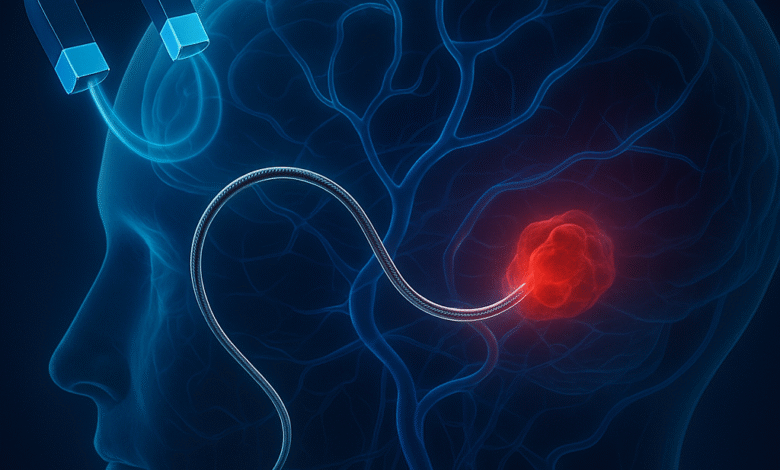Microrobot Thread: MIT’s Tiny Thread to Save Brain Lives

Imagine a battlefield where the enemy is unseen, a clot lurking deep within your brain’s blood vessels, threatening to shutter flow and inflict irreversible damage. Now envision a lifeline—a microscopic thread, guided by magnetic fields, weaving its way through the labyrinth of your cerebral arteries, clearing the pathway without a single incision. This isn’t sci-fi—it’s the reality of the MIT-engineered robotic thread for clot-clearing, and it may one day revolutionize stroke treatment.

The Stroke Challenge
Strokes rank among the leading causes of death and disability worldwide. The difference between life and devastating injury often hinges on the “golden hour”—the first 90 minutes post-stroke—during which swift intervention can preserve brain tissue and cognitive function. Traditional treatment involves threading rigid guidewires through arteries, via groin or leg entry points, under X-ray (fluoroscopic) guidance, to reach and remove clots. The process is laborious, technically demanding, and exposes surgeons to radiation.
Threading Innovation
Enter MIT’s soft robotic breakthrough: a magnetically steerable, hydrogel-coated robotic thread. At its heart lies a nickel–titanium (nitinol) alloy, beloved for its springy yet flexible memory—a key trait for navigating the winding, delicate branches of cerebral vasculature. MIT NewsSci.News: Breaking Science News
Encased in a magnetically responsive rubbery paste filled with ferromagnetic particles, the core becomes controllable via external magnetic fields, much like manipulating a marionette. To reduce friction and enhance biocompatibility, the researchers added a smooth hydrogel coating—enabling safe gliding through sensitive vessel walls. MIT NewsSci.News: Breaking Science NewsScience Focus
Lab Breakthroughs
To test feasibility, the team crafted a life-sized silicone model of the brain’s blood vessels—derived from patient CT scans—complete with simulated clots and aneurysms. Filled with a blood-mimicking fluid, this replica served as a high-stakes testing ground. MIT researchers used an external magnet to guide the thread through tight bends and obstructions, successfully navigating the maze of vessels.
In an ingenious twist, they swapped the nitinol core for an optical fiber, demonstrating that the thread could deliver a laser payload directly to a targeted site—potentially to break up clots with laser energy in situ. MIT NewsThe Robot ReportNew Atlas
They also compared hydrogel-coated threads versus uncoated ones: the hydrogel dramatically reduced friction, lowering the risk of vessel damage and stuck segments. MIT NewsSci.News: Breaking Science News
Why It Matters
This technology could fundamentally shift stroke treatment. Rather than surgeons manually pushing guidewires—while enduring radiation exposure and navigating small, tortuous vessels—a magnetically guided thread can be controlled from outside the operating suite, even remotely via a joystick. This reduces risk to both patient and doctor while dramatically expanding access to minimally invasive intervention. MIT NewsSky NewsScience Focus
Moreover, combining clot-clearing capabilities—via drug delivery, laser, or mechanical action—with precise navigation could help reverse blockages during the critical golden hour, increasing survival and reducing long-term disability. MIT NewsThe Robot ReportNew Atlas
Hurdles Ahead
Despite its promise, the robotic thread faces several challenges before becoming standard care:
- From Model to Human: These experiments were conducted in silicone replicas. In vivo testing in animals, followed by human trials, is needed to ensure safety and reliability. Sky NewsMIT News
- Regulatory Path: Neurosurgery is high stakes. Adapting clinical workflows and securing regulatory approval will be complex and rigorous.
- Magnetic Control Infrastructure: Hospitals would need advanced magnetic navigation systems synchronized with imaging to control the thread accurately from a distance.
- Potential Tissue Damage: Even with hydrogel, untested biocompatibility and long-term effects must be evaluated.
Looking Ahead
Lead engineer Xuanhe Zhao and graduate student Yoonho Kim envision leveraging present-day magnetic platforms, enabling doctors to operate remotely—perhaps even from another room or city—using joysticks to manipulate the thread while viewing live fluoroscopy images. MIT NewsScience FocusSky News
Meanwhile, functional enhancements—attaching drug delivery capsules, laser emitters, or sensors—are on the horizon. MIT NewsThe Robot ReportNew Atlas
If realized, this could not only change how strokes are treated but also open pathways to remote, minimally invasive neurosurgery for brain aneurysms, tumors, or other intracranial conditions.
Conclusion
MIT’s microrobot thread may be an elegant solution to a deadly problem. In simulation models, it has proven it can slip through the brain’s tight, twisting vessels and tackle blockages without traditional surgery. Though human trials remain ahead, this technology promises to make life-saving neurosurgical care safer, faster, and more accessible.
If the golden hour truly defines outcomes after a stroke, this thread could be a lifeline—bridging time, space, and medical capability—to heal brains in a way once deemed impossible.
References
- MIT News: Robotic thread designed to slip through brain’s blood vessels. MIT News
- Xinhua / Sci-News: Clot-reducing therapies via robot thread. Xinhua NewsSci.News: Breaking Science News
- Sky News: “Worm robot” to clear brain clots. Sky News
- The Robot Report: Robotic thread for brain vessel navigation. The Robot Report
- BBC ScienceFocus: Flexible magnetic robot to stop brain damage.





